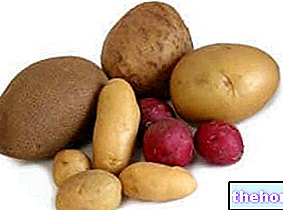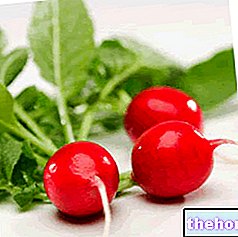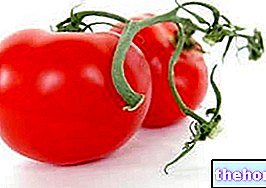King of the garden
A typical symbol of home gardens, celery is a very common biennial plant, both cultivated and spontaneous. Celery is widely used in cooking, for its particular aroma and for the ability to "hide" unpleasant flavors and smells, but it is also eaten raw, in dips and in salads. But that's not all: celery is even used in phytotherapeutic, herbal and cosmetic fields.
During the discussion we will deepen the general characteristics of celery, its botanical peculiarities, nutritional characteristics and the different food and therapeutic uses.
Generality and tradition

Celery has always been used as a diuretic, digestive and natural remedy for cramps.
Botanical characters
In botanical terms, celery is Apium graveolens, typically biennial herbaceous species but often cultivated on an annual cycle, belonging to the family of Umbelliferae. Celery grows spontaneously in grassy and marshy places, and can even reach heights of 80-90 centimeters, depending on the variety considered.
The plant has pinnate or bipinnate leaves, divided into three ovate-lobed segments; the leaves are rhombic and the margin is typically toothed or serrated.
The ribs of the leaves, wisely made white and fleshy through an appropriate cultivation, have a delicate and pleasant taste that lends itself well to the most varied culinary preparations.
The celery flowers, white or whitish, are grouped in umbels composed of 6-12 rays; the flower peduncles are quite robust.
The root of celery is a taproot: in some species, the root is large and round, and has an edible white pulp, with a flavor comparable to that of celery. In this case, the root is better known as celeriac - this is the variety rapaceum, also known as Verona celery (an entire in-depth article will be dedicated to celeriac).
The fruits of celery (called seeds) are small diachenes (mostly used for herbal purposes), varying in color from green to brown.
Celery: variety
The variety of celery is quite wide and varied: three of the most important varieties, we cannot forget the celery (variety sweet), of which the petiole of the leaves is used, fleshy and developed. In the dulce variety, the root is rather thin and underdeveloped, and is further classified on the basis of the color of the ribs (green, white or golden ribs).
Another very important variety of celery is the so-called cutting celery, with a characteristic strong and intense aroma: the leaves are used for this variety.
Last but not least, celeriac: as already mentioned in the previous paragraph, it is a very popular variety in Northern Italy: celery from Verona is grown for its globular, rounded and highly developed root, which can be consumed both raw and cooked.
Nutritional analysis
Celery boasts a very low calorie content: in 100 grams there are just 20 kcal. Water constitutes over 88% by weight, while the remaining 12% is divided between carbohydrates, proteins, fibers and fats (very few). Furthermore, celery is a source of mineral salts, such as iron, manganese and potassium, as well as being rich in antioxidants (vitamins A, C and E).
Essential oil

Health properties
In the previous paragraph we described the chemical composition of celery essential oil: scientific research has demonstrated its medicinal potential, and phytotherapy has learned to use them to create effective products in alleviating some ailments.
Initially, the antihyperlipidic property of celery was advertised, attributed to the phthalide molecule 3-n-butylphthalide: however, recently, although this ability has been ascertained, it was concluded that in all probability the molecule in question is not responsible for it. . It seems that celery acts as an excellent natural remedy to counteract the deposit of excess lipids, but the responsible of the action is the entire aqueous extract, not a single molecule.
In any case, 3-n-butylphthalide is involved in the hypocholesterolemic and antihypertensive action of celery.
Probably, celery plays a role - albeit marginal - at the level of the central nervous system: it is believed, in fact, that the consumption of celery acts as a mild antidepressant and anxiolytic, but this hypothesis still leaves a "shadow of perplexity among researchers.
Being very rich in minerals, celery also acts as an excellent natural remineralizer.
The diuretic, aperitif and digestive properties of the plant have been known since the past. Finally, celery juice is also used in the treatment of rheumatism, lung diseases, kidney stones and liver failure.
Food uses
More than for its medicinal properties, celery is grown in home gardens for its leading role in the kitchen: celery is in fact the main ingredient, together with onion and carrot, for the preparation of the sauté; at the same time, it is a a vegetable that certainly cannot be missing in the preparation of meat broth, and not even for cooking roasts and soups.
Raw, celery lends itself to the realization of pinzimonio and salads.
Celery in brief, summarized on celery "
Other Foods - Vegetables Garlic Agretti Asparagus Basil Beets Borage Broccoli Capers Artichokes Carrots Catalonia Brussels sprouts Cauliflower Cabbage and Savoy cabbage Red cabbage Cucumber Chicory Turnip greens Onion Sauerkraut Watercress Edamame Chives Chanterelles Flour Cassava Flowers Pumpkin Flour Edible Flowers Pumpkin Seasonal Fruits and Vegetables Endive Salads and Salads Strengthening Salad Lettuce Aubergines Vegetables Nettle Pak-Choi Parsnip Potatoes American Potato Peppers Pinzimonio Tomatoes Leeks Parsley Radicchio Turnips Red Turnips Radishes Rocket Shallots Endive Celery Celeriac Seeds Sprouted Spinach Truffle Valianamberi or Jerusalem artichoke laxatives Saffron Pumpkin Zucchini Vegetables - Nutritional properties OTHER VEGETABLE ITEMS Categories Food Alcoholics Meat Cereals and derivatives Sweeteners Sweets Offal Fruit Dried fruit Milk and derivatives Legumes Oils and fats Fish and fishery products Cold cuts S pezie Vegetables Health recipes Appetizers Bread, Pizza and Brioche First courses Second courses Vegetables and Salads Sweets and Desserts Ice creams and sorbets Syrups, liqueurs and grappa Basic preparations ---- In the kitchen with leftovers Carnival recipes Christmas recipes Light diet recipes Women's Day, Mum, Dad Recipes Functional Recipes International Recipes Easter Recipes Recipes for Celiacs Recipes for Diabetics Recipes for Holidays Recipes for Valentine's Day Recipes for Vegetarians Protein Recipes Regional Recipes Vegan Recipes




























